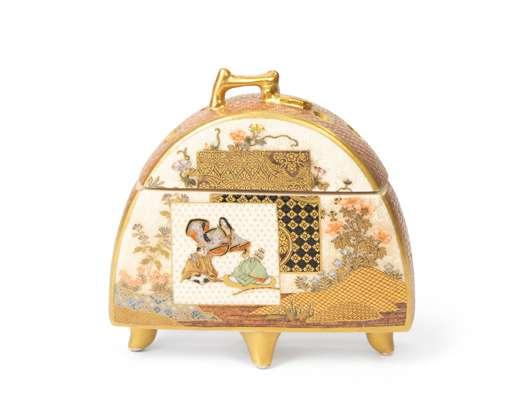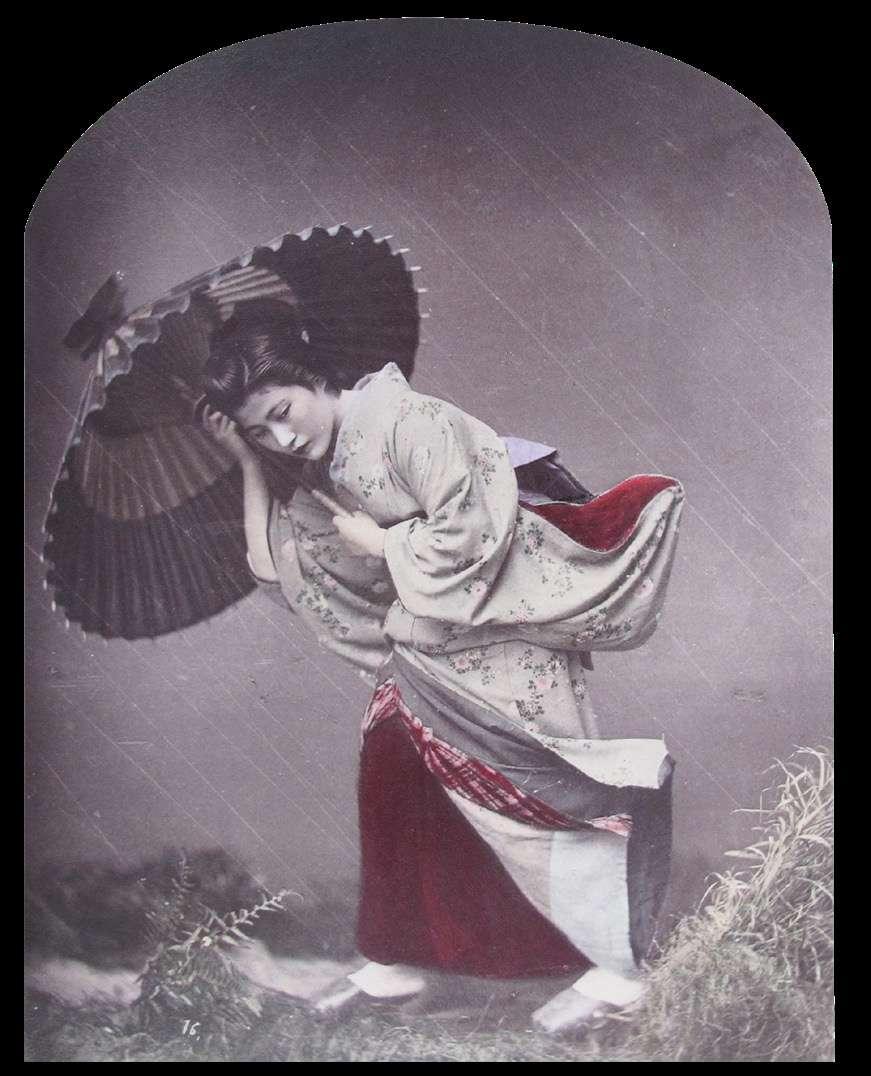
16 minute read
JAPANESE CERAMICS
Lots
91 A RARE JAPANESE KO-KUTANI VASE
EDO PERIOD, 17TH CENTURY
The double-gourd vessel with a narrow waist and a tall slender neck, the eight-sided body decorated with medallions enclosing pine, bamboo and prunus branches on a band of karakusa scrolls; embellished with further formal designs, tortoiseshell and cash patterns, all rendered in thick enamels; the base left unglazed, 18.3cm.

£3,000-5,000 related Ko-Kutani vase decorated with karakusa scrolls and cash patterns.
† A LARGE AND IMPRESSIVE JAPANESE BLUE AND WHITE CHARGER
EDO PERIOD, C.1670-80
Elegantly painted to the well with flowering chrysanthemum and peony by a triangular fence, the rim with a wide band of five lotus flowers and leafy scrolling tendrils, the reverse left undecorated and with several spur marks, 53.5cm.
£12,000-15,000
Provenance: purchased in Paris, by repute.
Cf. J Ayers, Chinese and Japanese Works of Art in the Collection of Her Majesty The Queen, vol. II, p.631, no.1471-1472, for a pair of related dishes (access. no. RCIN58949). Also, see C J A Jörg, Fine & Curious, Japanese Export Porcelain in Dutch Collections, p.130, no.138, for a similarly decorated dish in the Groninger Museum, Groningen.

A LARGE JAPANESE LACQUERED VASE EDO PERIOD, 18TH CENTURY

The surface of the bulbous body decorated all over in gold, red and black lacquer, with two large ho-o birds depicted in flight above paulownia, their long tail feathers trailing behind them, the neck and foot with borders of karakusa scrolls; some areas with traces of unrelated underglaze blue decoration underneath, 43cm.
£300-500
Provenance: from the collection of Charles William Martin (1850-96) of Quorn Place, Leicestershire. In 1886, Martin founded the Quorn Ranch Company in Alberta, Canada, one of the most famous British North Amerian ranches, importing British horses and Angus cattle to the area. See lot 261 for another Japanese piece from the same collection.

A PAIR OF LARGE AND IMPRESSIVE JAPANESE ARITA LACQUERED VASES EDO PERIOD, 1690-1720

The bulbous bodies decorated in underglaze blue with cloud-shaped panels of dense foliage and peony flowers, with large gilded lacquer areas enclosing many prancing shishi, the lion dogs depicted in a variety of poses, with branches of bamboo and flowers above them and on a cell diaper ground, the necks with a lacquer border decorated with coiling dragons and shachihoko (dragon fish), 60cm and 59cm respectively. (2)
£800-1,200
Cf. O Impey, Japanese Export Porcelain, Catalogue of the collection of the Ashmolean Museum, Oxford, p.119, no.151, for a jar of similar shape and underglaze blue painting lacking its lacquer decoration.
96
A RARE JAPANESE BLUE AND WHITE DRUG JAR FOR THE WESTERN MARKET

EDO PERIOD, C.1650
The tall cylindrical body with a waisted spreading foot and an everted rim, painted in underglaze blue with a narrow blank cartouche framed by formal scrolling designs with stylised leaves and swags, the shading rendered with cross-hatching of a darker shade; the banderol embellished with an unusual depiction of a moustached male harpy wearing a neck ruff or millstone collar, perched on an orb; heavily potted with some of the recessed base left unglazed, 28cm.
£5,000-8,000
C J A Jörg, Fine & Curious, Japanese Export Porcelain in Dutch Collections, pp.213-217 for other examples of drug jars for the Western market. Also, see O Impey, Japanese Export Porcelain, Catalogue of the collection of the Ashmolean Museum, Oxford, pp.42-43, for another blue and white jar (pictured right with lot 96).
95
A JAPANESE BLUE AND WHITE CYLINDRICAL JAR
EDO PERIOD, C.1660-80
The tall cylindrical body painted in underglaze blue with panels enclosing peonies in vases and sprays of chrysanthemum, framed by formal scrolling motifs, the shoulder and neck decorated with bands of lappets and chevrons, 30.5cm.

£600-800
Cf. G Lang, The Wrestling Boys, An exhibition of Chinese and Japanese ceramics from the 16th to the 18th century in the collection at Burghley House, p.19, no.53, for a related jar. Also, see J Ayers, O Impey, JVG Mallet, Porcelain for Palaces, The Fashion for Japan in Europe 1650-1750, p.107, no.55, and O Impey, Japanese Export Porcelain, Catalogue of the collection of the Ashmolean Museum, Oxford, p.99, no.105, for a square-section jar with comparable decoration.
This apothecary jar is an unrecorded and possibly unique example. The shape is based on the European albarello (probably from the Arabic term al barani, meaning storage), a container used for spices, herbs and other medicinal products. The European model derived from Persian and Syrian jars from the 12th-13th century. This Japanese example dates from c.1650 and was probably made as a special order. The depiction of a male harpy wearing a neck ruff is very unusual, and may have been the armorial used by a particular monastery or apothecary.
Comparing this piece to the jar at the Ashmolean Museum (see picture opposite) shows how these pieces were produced in a similar manner, heavily potted and with the surface covered in a thick white splashed glaze. The cobalt-blue decoration on both jars features shading rendered with cross-hatchings in a darker shade of blue. Dr Oliver Impey noted that no prototypes for this type of decorative labels have been found in Dutch earthenware. However, as the fashion for neck ruffs only stretched into the 17th century in the Dutch Republic, it is likely that the harpy decoration was based on a Dutch model rather than a Portuguese one. The winged creature is also reminiscent of angel-like figures with neck ruffs that can be found on 17th and 18th century Dutch jars or apothekerspots
The first recorded order for Arita porcelain by the VOC (1653) included ‘various (small) porcelain bottles, (small) pots, salve and preserve pots for the surgeon’s shop in Batavia, made according to the samples sent’. Other such orders were passed for ‘large and small medicine pots’ to be shipped to Taiwan, and for other unrecorded destinations. Shards of Japanese albarelli were also found in the shipwreck of the Oosterland, a VOC ship wrecked at the Salt River Mouth, South Africa. This jar was possibly made as part of one of these orders.
We would like to thank Clare Pollard and Guido Rabbeljee for their kind assistance and suggestions in researching this lot.
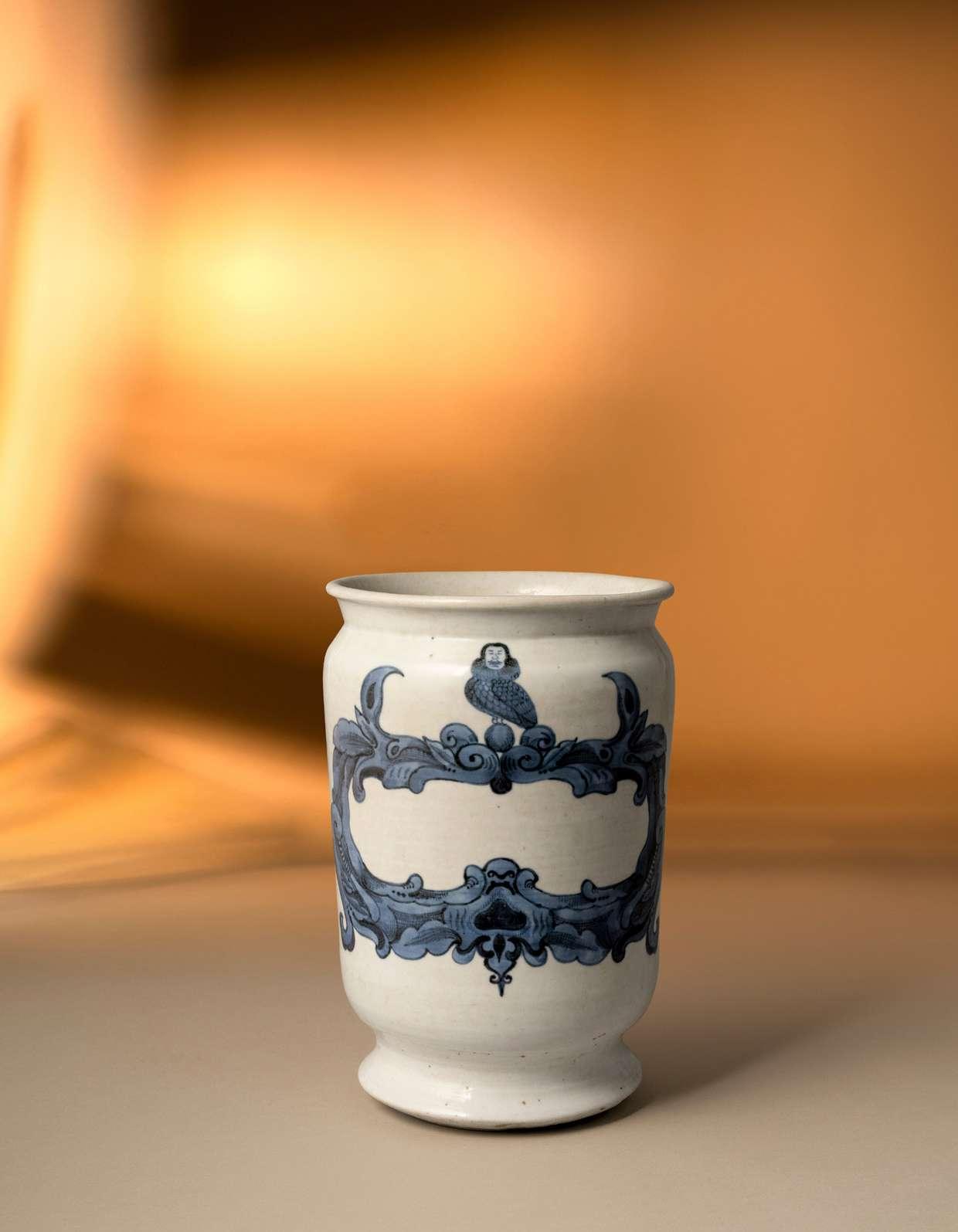
97
A JAPANESE BLUE AND WHITE BOTTLE VASE

EDO PERIOD, 17TH CENTURY
The slender body with a tall straight neck, decorated in underglaze blue with garlands of prunus blossoms and tassels, the neck with a band of lappets; three rings above the foot and the base left undecorated, 26cm.
£800-1,200
98
A JAPANESE BLUE AND WHITE MELON-SHAPED DISH
POSSIBLY EDO, 18TH OR 19TH CENTURY
Raised on an oval foot and moulded to the well with a large leaf and tendrils, decorated with a light blue wash, 16.2cm.

£800-1,200
99
A SMALL AND UNUSUAL JAPANESE SHELL-SHAPED DISH
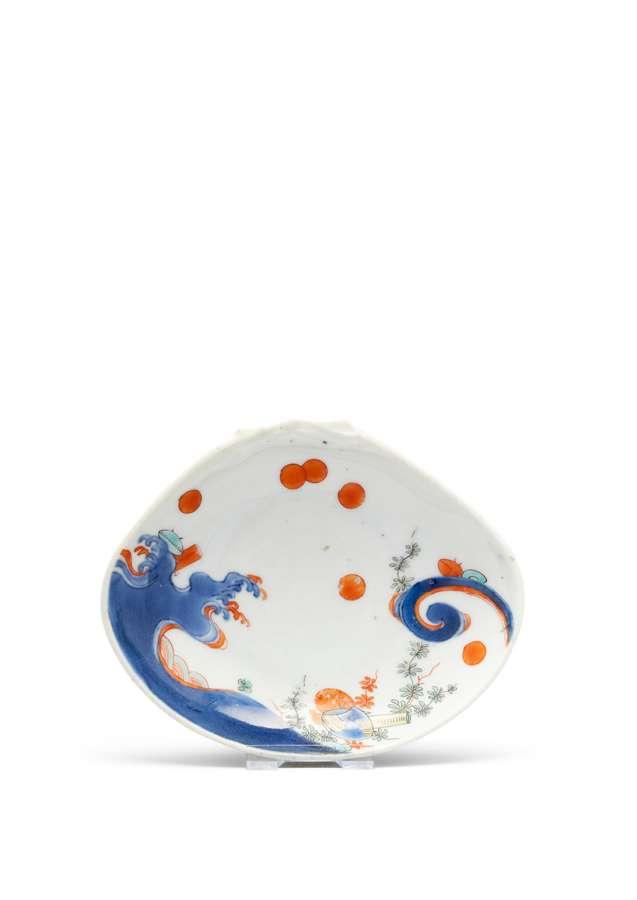
EDO PERIOD, 17TH CENTURY
The moulded body raised on a short foot, decorated to the well in underglaze blue and polychrome enamels with a design of crashing waves, with further shells and seaweeds floating on the surface of the water, the underside with karakusa scrolls and the base with a two-character seal mark, 13.9cm.
£300-500
Cf. M Fitski, Kakiemon Porcelain, a Handbook, p. 165, where the author illustrates a comparable mark and explains that it is unidentified, but it occurs on pieces from the Nangawara kiln produced between 1670-1700.
100
A RARE JAPANESE BLUE AND WHITE DRUM-SHAPED TEAPOT EDO PERIOD, 17TH CENTURY
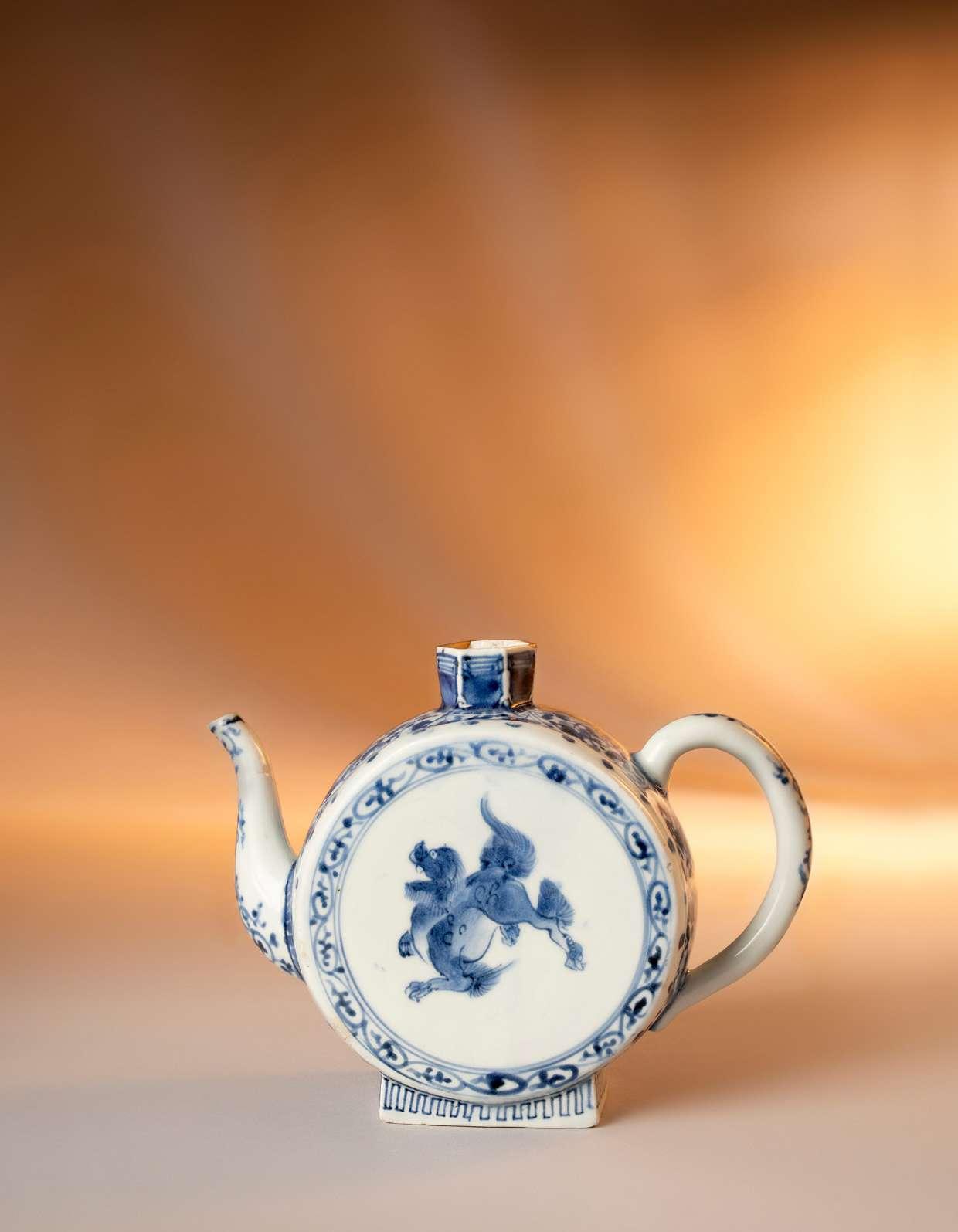
The unusual flattened circular body raised on a short rectangular foot, the sides with a curved spout and a rounded handle, a hexagonal neck above; painted in underglaze blue with a prancing shishi to each side, framed by bands of karakusa scrolls and leafy tendrils, 15.5cm.
£800-1,200
101
TWO JAPANESE BLUE AND WHITE DISHES EDO PERIOD, 17TH CENTURY
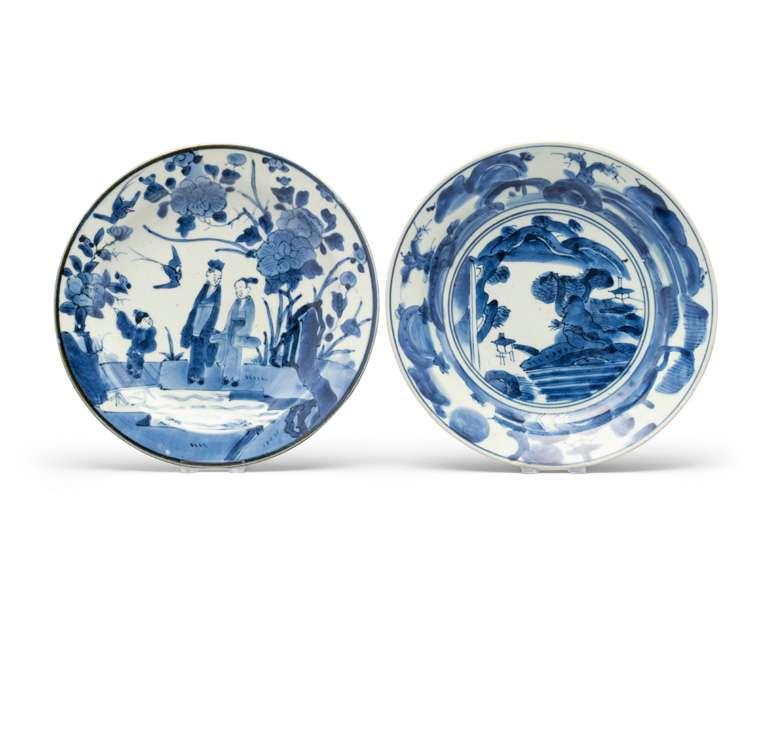
Both decorated in underglaze blue, one with two pavilions in a dramatic mountainous landscape with a waterfall to the side, the rim with a wide band enclosing another panorama; the other plate with two adults and a child on a bridge, the small boy pointing at a large poppy and with further blooms to the side, two birds in flight above, 21.5cm and 21.4cm respectively. (2)
£300-500
102
A JAPANESE BLUE AND WHITE KAKIEMON-STYLE DISH


EDO PERIOD, 17TH CENTURY
The ten-sided body with a brown rim and decorated in underglaze blue with a central medallion enclosing two figures in a landscape, a small dog prancing beside them, a waterfall, prunus and pine issuing from banded hedges behind; the cavetto and rim with a border of flowers, tassels and other formal designs; the reverse with karakusa scrolls and a kin mark in a double-lined square, 18.2cm.
£200-400
Provenance: from the collection of David Stopher, Kent.
103
A LARGE JAPANESE BLUE AND WHITE DISH EDO PERIOD, 17TH CENTURY
The ten-sided foliate dish decorated in underglaze blue and with a brown rim, painted with two men in Chinese garments seated in a pavilion and two others on a bridge, with prunus, pine and maple trees issuing from rockwork to the side, and scrolling clouds above; the reverse painted with a continuous band of karakusa scrolls and a fuku mark, 29.8cm.
£1,000-2,000
A JAPANESE BLUE AND WHITE KAKIEMON-STYLE DISH EDO PERIOD, C.1680-1720

The shallow dish raised on a short foot and with a foliate brown-edged rim; decorated in underglaze blue to the well with a ho-o bird perched on a flowering branch of chrysanthemum issuing from rockwork; the rim with a border of formal flowerheads and scrolling tendrils; the reverse with karakusa scrolls and a fuku mark in a double-lined square to the base, 15.6cm.
£300-500
See p.75 of this catalogue for another view.
A JAPANESE ARITA ‘QUAIL AND MILLET’ DISH EDO PERIOD, C.1700-20
The octagonal body decorated in underglaze blue, gilt and polychrome enamels; the two plump birds pecking seeds underneath tall sprays of millet and other flowers, the reverse with four beribboned sacred pearls, a paper label for ‘Girton Two Quail Collection, 2004 Loan Exhibition, no.2’, 17.4cm.
£300-500
Provenance: from the collection of David Stopher, Kent. Purchased from Bonhams, Fine Japanese Art, 12th May 2011, lot 103.
Exhibited: Stockspring Antiques, London, 6th-20th May 2004, and The Museum of Worcester Porcelain, Worcester, 2nd July-5th September 2004, no.2, as part of the exhibition ‘The Two Quail Pattern, 300 Years of Design on Porcelain’ and illustrated in the catalogue, p.77.
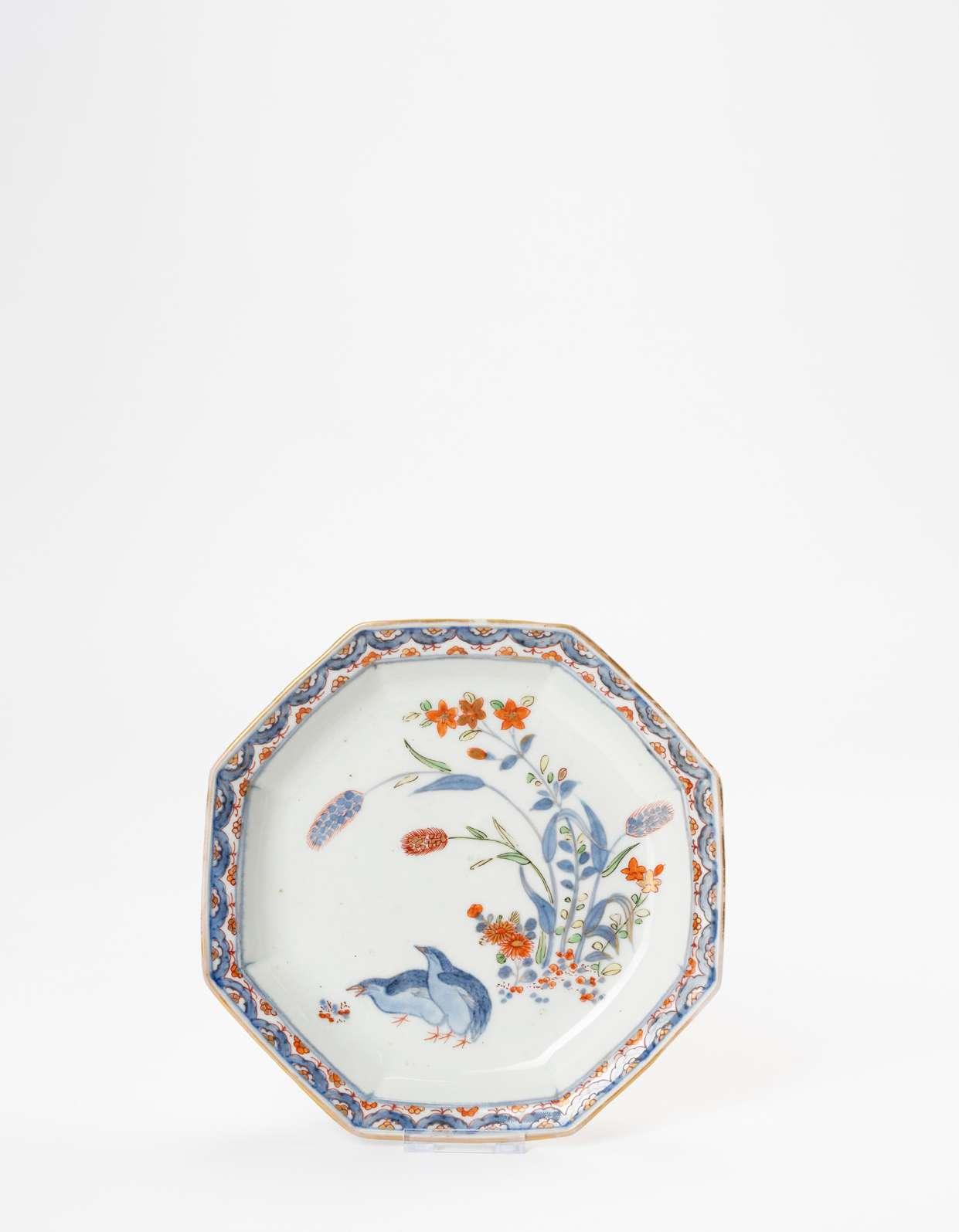
A TALL AND RARE JAPANESE KAKIEMON-STYLE EWER EDO PERIOD, C.1660-80

The bulbous body with a slender neck and a curved handle to the side, decorated in underglaze blue, red, black and green enamels; the body painted with pavilions in a mountainous river landscape, surrounded by luxuriant gardens and with large palm trees behind them; the neck embellished with further blooms and formal floral designs, the handle with karakusa scrolls, 26.7cm.
£1,000-2,000
Cf.C J A Jörg, Fine & Curious, Japanese Export Porcelain in Dutch Collections, p.161, no.181, for a closely related ewer in the Groninger Museum, Groningen. The author notes that the combination of a Chinese Transitional-style landscape in underglaze blue and the enamelled decoration is very unusual, and it places this piece between the early Japanese enamels and the developing Imari and Kakiemon styles. He also notes that no other comparable piece seems to be recorded.
107
A JAPANESE KAKIEMON BOWL EDO PERIOD, C.1700

The deep body moulded as a five-petalled flower and raised on a short straight foot, richly painted in polychrome enamels with a single bloom to the well and flowering prunus trees and flowers emerging from behind fences to the cavetto; the exterior with a large fruiting pomegranate tree and further flowering prunus issuing from rockwork, 19cm.
£600-800
Provenance: from the collection of David Stopher, Kent. Purchased from Bonhams, Fine Japanese Art, 11th November 2010, lot 237.
108
A PAIR OF JAPANESE FOLIATE DISHES

EDO PERIOD, 1670-1700
Both decorated in underglaze blue, gilt and red enamel with a five-petal flower to the centre and radiating panels to the cavetto enclosing further blooms and leafy sprays; both painted to the reverse with karakusa scrolls and a single character mark, both 18.2cm. (2)
£400-600
Cf. M Fitski, Kakiemon Porcelain, A Handbook, p.165, where a similar mark is illustrated. Although the author explains that the character is unidentified, it occurs on Nangawara pieces produced between 1670-1700.
109
A LARGE JAPANESE IMARI BOWL

EDO PERIOD, 17TH CENTURY
The deep body typically decorated in underglaze blue, gilt, yellow, green, cyan, orange and red enamels, the well with a peony to the centre and the cavetto with two beribboned sprays of chrysanthemum and irises, a band of blue spirals to the rim embellished with gilt; the reverse decorated with alternating panels enclosing various flowers including chrysanthemum, carnations, lotus and others, above a continuous band of prunus branches, the foot painted with spirals, 31.4cm.
£1,000-1,500
A LARGE JAPANESE IMARI BOWL EDO PERIOD, 17TH CENTURY
The deep body decorated in underglaze blue, gilt, yellow, red, orange, green and purple enamels, the well painted to the centre with a spray of peony and the cavetto with chrysanthemum tied up to bamboo canes, the rim with a band of clouds and fruiting branches in gilt on the dark blue ground; the reverse with a mountainous river landscape above two floral borders; an elderly man and two boy attendants crossing a bridge to one side, and a pavilion by a waterfall to the other, the base with a chrysanthemum mon, 37.7cm. £800-1,200

111
A PAIR OF JAPANESE ARITA DISHES
EDO PERIOD, 1690-1720
Both decorated in underglaze blue, gilt, red, yellow, cyan and green enamels, each with a central medallion enclosing two tripod jardinières issuing rocks and flowers by a fence, framed by a wide border of further blooms, leafy branches, rocks and fences; the rims with borders of stylised waves and flowers; both dishes painted to the reverse with prunus flowers and leafy tendrils, 31.3cm. (2)

£1,000-1,500
112
† A LARGE JAPANESE IMARI DISH
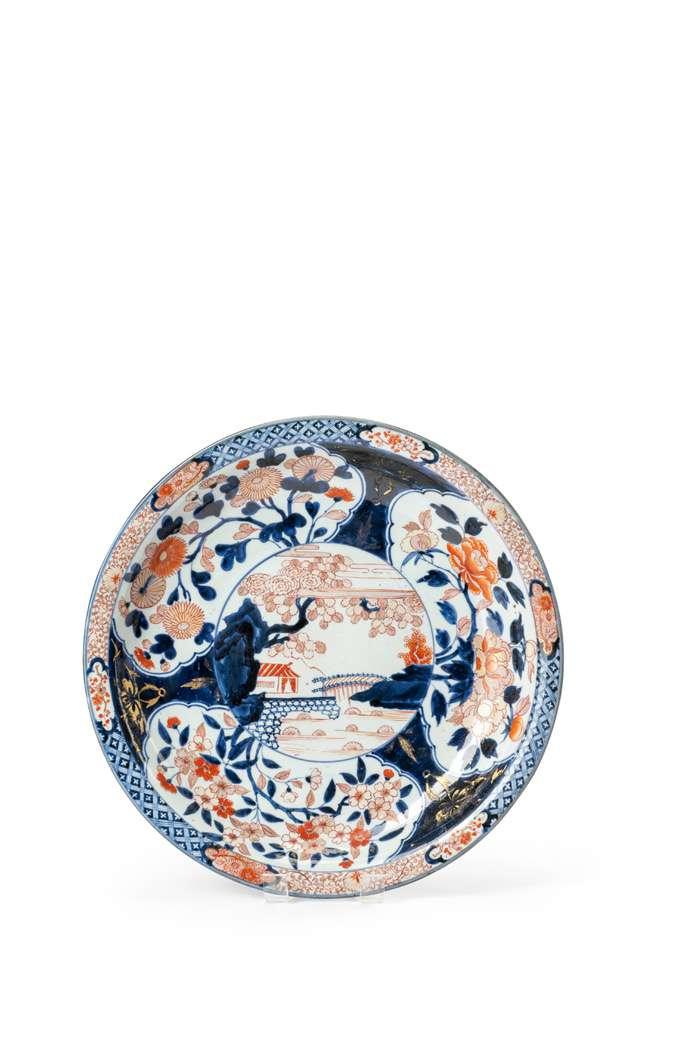
EDO PERIOD, 1690-1720
Decorated in underglaze blue, gilt, and red enamel, the well painted with a pavilion by a bridge, a large tree issuing from rockwork beside it; the cavetto with shaped panels enclosing flowering chrysanthemum, prunus and peony, and a formal border of scrolling tendrils, diaper and further blooms to the rim; the reverse with foliate scroll decoration, 48.5cm.
£1,500-2,500
A PAIR OF VERY LARGE AND IMPRESSIVE JAPANESE IMARI DISHES EDO PERIOD, 1690-1720
Both richly decorated in underglaze blue, gilt, yellow, green, purple and red enamels, each painted with sprays of flowering chrysanthemum to the well encircled by scrolling tendrils, the cavetto with figures in a mountainous river landscape and with many chrysanthemum, peonies, prunus and other blooms, the rims of both dishes with alternating panels enclosing formal leafy tendrils and further chrysanthemum flowers, the undersides both painted with three flower sprays, 55.5cm and 55cm respectively. (2) £10,000-15,000
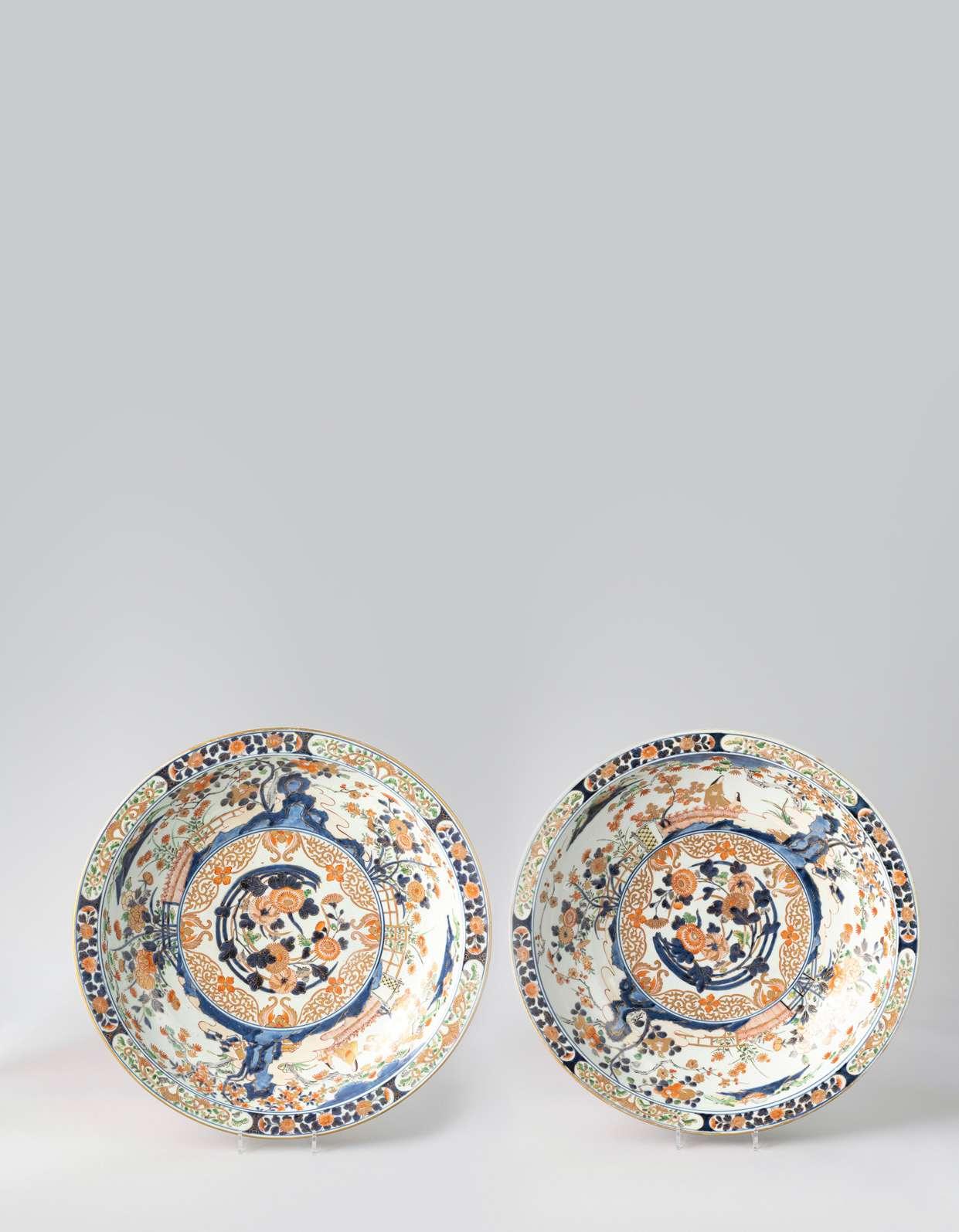
115
† A TALL JAPANESE IMARI BALUSTER VASE EDO PERIOD, 18TH CENTURY
The baluster body richly decorated in underglaze blue, gilt and polychrome enamels, with panels shaped as ribbons and fans variously enclosing figures in landscapes, flowers, squirrels and vines, carps and butterflies, all reserved on a dark navy-blue ground embellished with flowers and scrolling tendrils in gilt, 58cm.
£5,000-6,000
See Japanese Works of Art, 1st July 2020, lot 218, for a pair of Imari vases from the collection of Lionel de Rothschild (1882-1942), Edmund de Rothschild (1916-2009), and the Trustees of Exbury House, with similar decoration of fan and ribbon-shaped panels on a dark blue ground sold in these rooms. The ribbon-shaped cartouches on this vase imitate the decorative strips of paper known as tanzaku on which one would write a wish during the Tanabata festival.

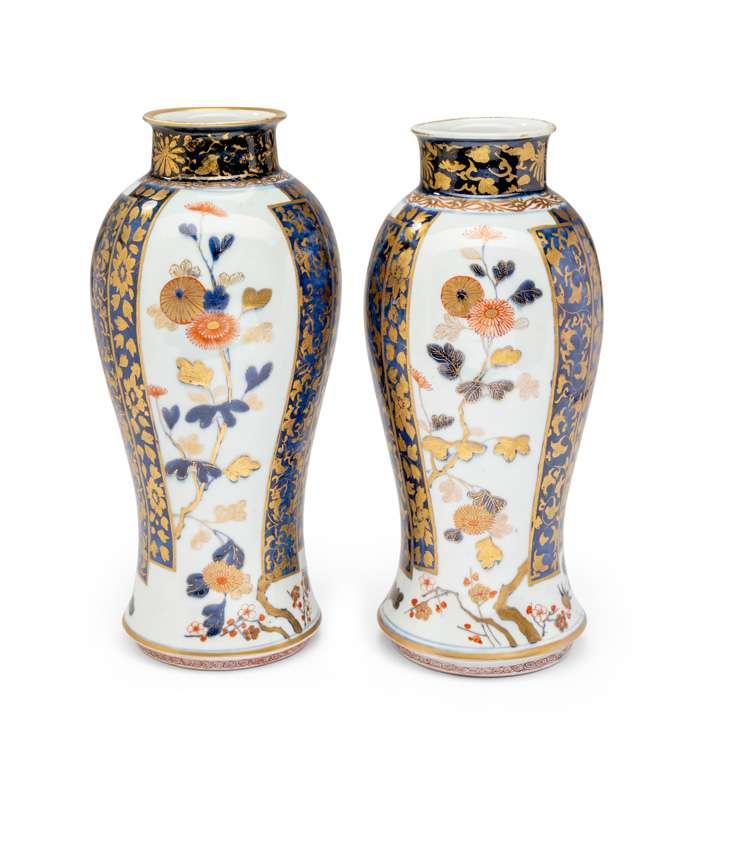
114
† A PAIR OF JAPANESE IMARI VASES EDO PERIOD, C.1700-1730
The baluster bodies typically decorated in underglaze blue, gilt, orange and red enamels, painted with flowering branches of peony and prunus in between ribbons, the dark blue rectangular panels embellished with formal scrolls and flowering tendrils rendered in gilt, both approx. 34cm. (2)
£3,500-4,000
† A LARGE AND IMPRESSIVE JAPANESE IMARI DISH EDO PERIOD, 1690-1720
Richly painted in underglaze blue, gilt, and polychrome enamels, the well decorated with two birds of prey, one perched on a flowering branch of peony, the other immobilising a smaller bird; the border with shaped panels enclosing various birds, flowers and squirrel and vines on a dense ground of karakusa scrolls, the reverse with three sprays of chrysanthemum, prunus and peony, 50cm. £4,000-6,000
See the Victoria and Albert Museum, access. no.C.1503-1910 for a related dish.

118
† A PAIR OF JAPANESE IMARI TOKKURI (BOTTLES)

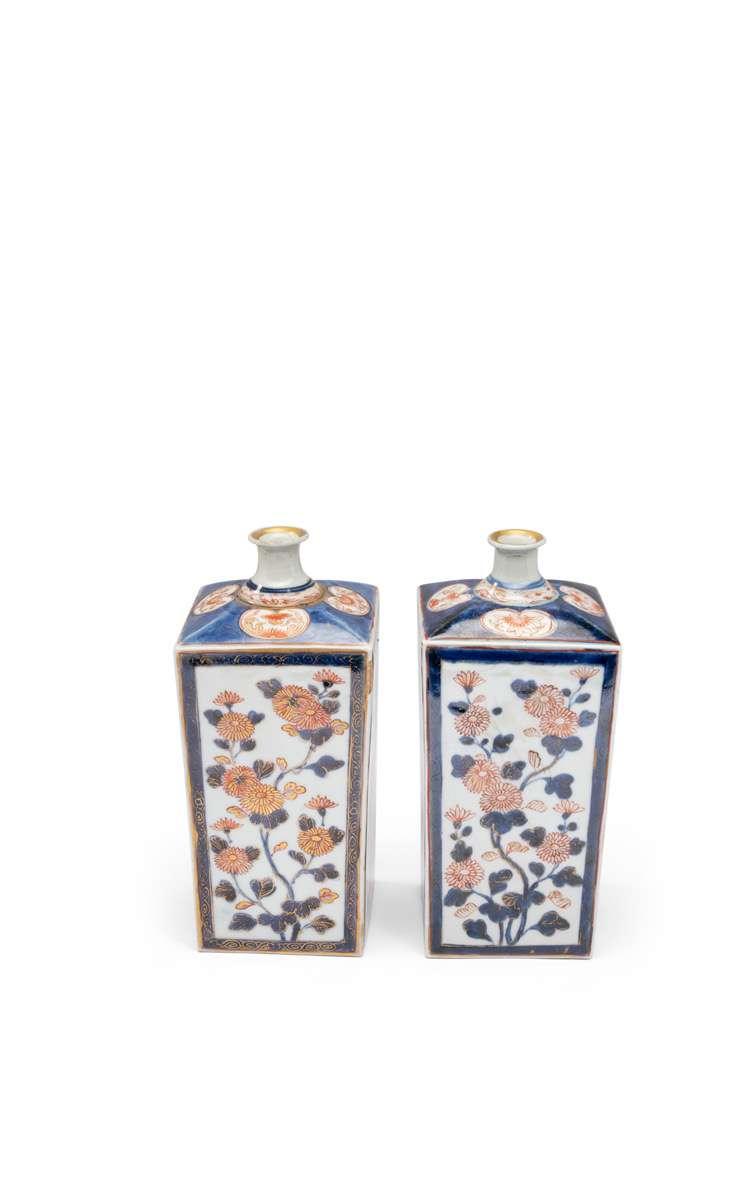
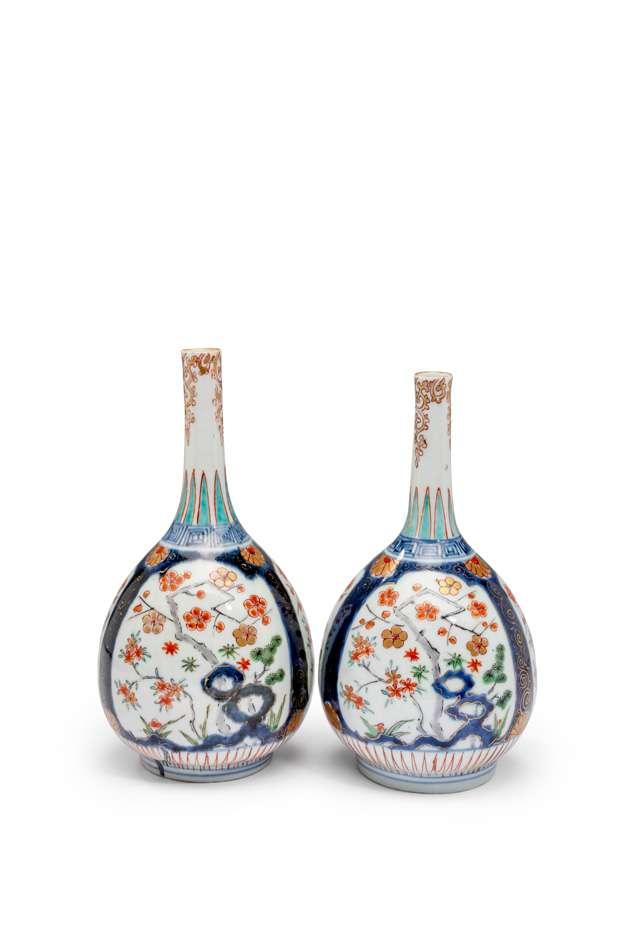
EDO PERIOD, C.1700
The square-section bodies richly decorated in underglaze blue, gilt, and red enamels, each side with flowering sprays of chrysanthemum, both bottles painted to the shoulder with formal designs in shaped panels and bands of writhing dragons above, both approx. 23cm. (2)
£3,500-4,000
117
† AN UNUSUAL JAPANESE IMARI MOULDED DOUBLE-GOURD VASE
EDO PERIOD, 18TH CENTURY
Painted in underglaze blue, gilt, red, green and purple enamels, with many chrysanthemum, peony and other blooms amongst leafy sprays, some flowers depicted in slight relief and two others with details unusually rendered in openwork, 29.5cm.
£1,500-2,500
119
† A PAIR OF JAPANESE IMARI BOTTLE VASES
EDO PERIOD, C.1700
Both decorated in underglaze blue, gilt, red, green, cyan and purple enamels; painted with panels enclosing flowering branches of prunus and other flowers issuing from rockwork; each with a band of triangular lappets above the foot and to the neck, and with karakusa scrolls to the rim, 23cm and 22cm respectively. (2)
£2,500-3,000
120
† A LARGE AND UNUSUAL JAPANESE IMARI MOULDED BOX AND COVER EDO PERIOD, 18TH CENTURY

Of square shape and raised on a short foot, the heavily potted box richly decorated with shaped panels enclosing flowers, grapes, vines, and landscapes, some areas embellished with patterns of cell diaper; the decoration moulded in low relief; all framed by borders of stylised peonies and scrolling tendrils; the cover made of lacquer and decorated with various mon in gold hiramaki-e on the black roiro ground, 21cm x 20.3cm x 19.9cm. (2)
£2,000-3,000
Cf. O Impey, Japanese Export Porcelain, Catalogue of the collection of the Ashmolean Museum, Oxford, p.212 for another 18th century square box with moulded honeycomb pattern. The author notes that the moulded decoration has been especially adapted in order to take the particular painted pattern, thus showing close collaboration between potter and painter.
121
† A JAPANESE FOUR-TIER JUBAKO (PICNIC BOX AND COVER) MEIJI ERA, 19TH CENTURY
The square-section stacking box decorated with shaped panels enclosing bamboo, prunus, and pine on a ground of seigaiha waves, the cover painted with poppies and bamboo shoots on a fylfot ground, 21cm. (5)
£1,000-1,500
123
A SET OF SEVEN JAPANESE HIRADO MODELS OF BOYS


MEIJI ERA, 19TH/20TH CENTURY
The children are all depicted seated in a variety of poses, each wearing a tunic and loose trousers with details highlighted in underglaze blue and iron oxide, in an inscribed tomobako wood box with seven compartments, 6cm max. (8)
£1,000-2,000
122
A JAPANESE HIRADO MODEL OF DOGS

EDO OR MEIJI, 19TH CENTURY
The charming okimono depicting a bitch and her two puppies, the adult with a blue collar and all three with a yellow-brown ribbon tied around the neck, one pup clambering upon the back of its parent whilst the other calmly looks up, with some details delicately incised in the surface, 13.2cm.
£300-500
Of bulbous shape and with a ring to the neck, decorated with many mythical creatures including dragons, ho-o birds and shishi; the beasts on a dense ground of white scrolling tendrils; bordered by bands of flowers, brocade patterns and other formal designs, the base signed Kinkozan zo, 12.5cm.

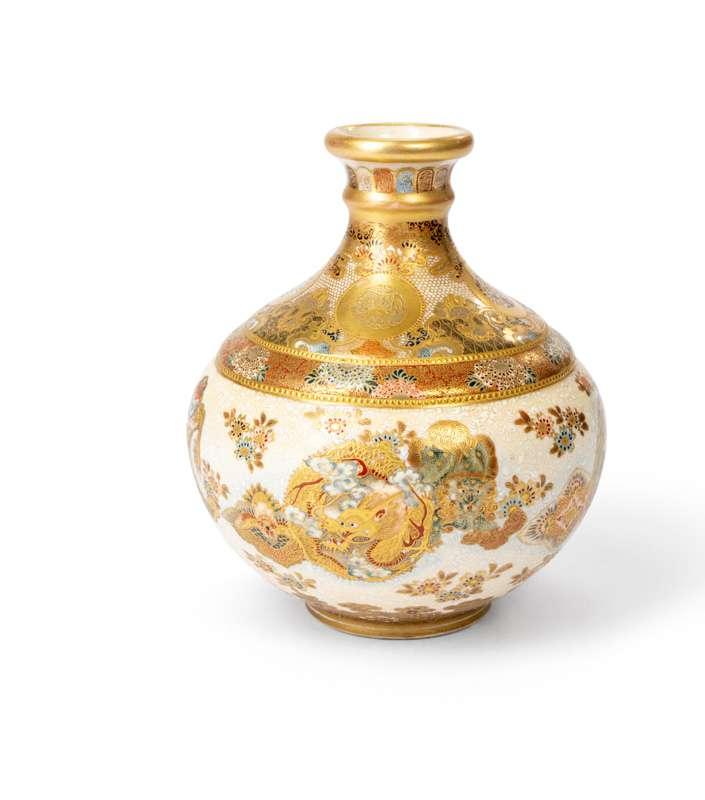
£300-500 125
Both with a bulbous body decorated with a central scalloped band enclosing a procession, the many figures including a sarumawachi (monkey trainer), a man with a lion mask for the shishimai dance, children with toys, musicians, samurai, and beauties with parasols; the panels framed by borders of flowerheads and brocade patterns, both with a square mark underneath for Hiramatsu Genzan, both 12.3cm. (2)
£500-800
A JAPANESE CYLINDRICAL VASE BY MEIZAN MEIJI ERA, 19TH CENTURY

Raised on three short feet, richly decorated with a wide band enclosing a continuous scene in between borders of flowerheads and key fret, the panel painted with many figures in an extensive mountainous river landscape, some depicted walking in the snow and others seating in pavilions, one looking through a telescope; the base signed in gilt Meizan sei in a rectangular cartouche, 14.8cm.
£500-1,000
127
A JAPANESE SATSUMA VASE BY YABU MEIZAN MEIJI ERA, 19TH CENTURY

The tall body decorated with a continuous design of swallows flying amongst wisteria, the flowers and vines trailing down the side of the vase, the petals painted in slightly raised enamels and with details highlighted in gilt, the rim embellished with formal scrolling tendrils and flowerheads, the base sealed Yabu Meizan in gilt, 24.3cm.
£400-600
A GOOD JAPANESE SATSUMA VASE BY KINKOZAN MEIJI ERA, 19TH/20TH CENTURY

The slender baluster body embellished with two large panels, one painted with an elegant beauty wearing ornate kimonos in luxuriant gardens, with large peonies, a flowering prunus tree and bamboo, a small butterfly fluttering to the side; the other side with further blooms; on a dense ground of sakura flowers rendered in gilt on the navy-blue ground; the base painted with a leafy branch of maple and signed on an omikuji paper strip Kinkozan zo, 21.5cm.
£2,500-3,000

129
A Tall Japanese Satsuma Vase By Dozan
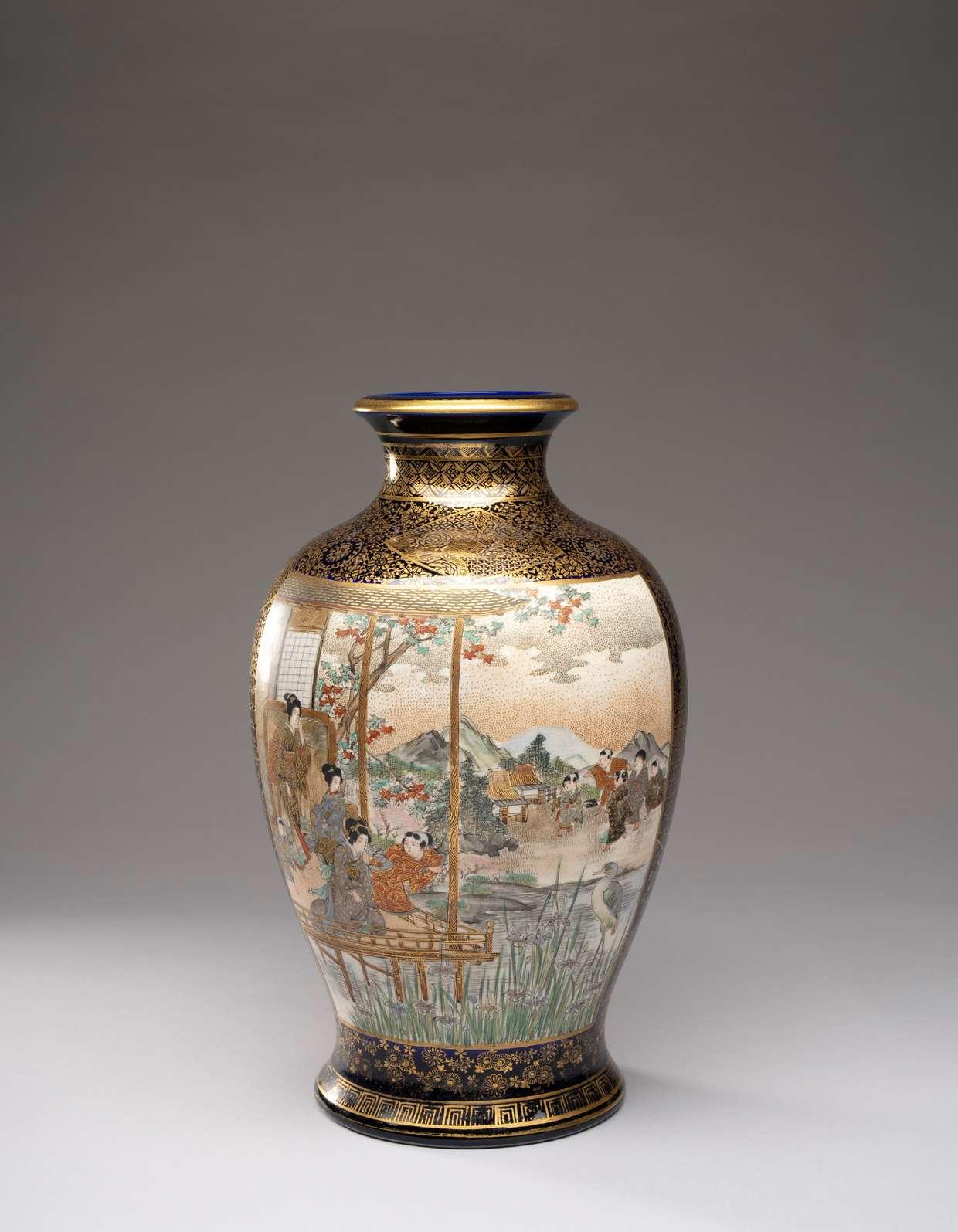
The bulbous body raised on a slightly spreading foot and with a flared neck, decorated with two large panels enclosing many figures, one side with beauties and children by a gate feeding chickens, the reverse with further women and boys on a terrace overlooking a pond; all reserved on a dark navy-blue ground decorated with dense brocade patterns and flowerheads, the base signed Dozan in a rectangular cartouche, 30.5cm.
£500-1,000
130
A JAPANESE SATSUMA VASE BY KINKOZAN
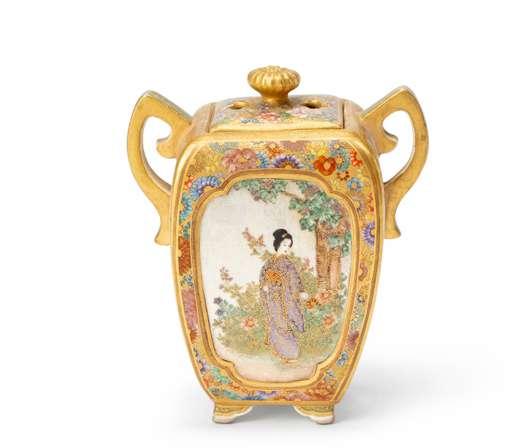
MEIJI ERA, 19TH CENTURY
The square-section body with a tapered foot and short neck, each side decorated with a large panel enclosing flowering sprays of chrysanthemum, prunus, wisteria and other blooms, one panel with butterflies fluttering above a woven bamboo fence; the shoulder richly decorated with a dense pattern of flowers and scrolling tendrils, the base signed and impressed Kinkozan, 15cm.

£400-600
131
AN UNUSUAL JAPANESE SATSUMA KORO (INCENSE BURNER AND COVER) BY KINKOZAN
MEIJI ERA, 19TH/20TH CENTURY
Of semi-circular shape and raised on four slightly curved feet, each side richly decorated with panels enclosing figures and brocade designs, on a ground of flowers emerging from rockwork decorated with geometric patterns, the sides with shippo tsunagi cash decoration and the cover with a handle shaped as a gnarled branch, with four circular apertures, the base signed Kinkozan sei in a rectangular reserve, 9cm. (2)
£300-500
132
A FINE JAPANESE SATSUMA KORO (INCENSE BURNER AND COVER) BY KINKOZAN
MEIJI ERA, 19TH CENTURY
The square-section body raised on four shaped feet and applied with scrolling handles, delicately painted with two shaped panels enclosing a beauty in a luxuriant garden to one side and a pavilion in a mountainous landscape to the other, on a dense ground of flowerheads embellished with a profusion of gilt and polychrome; the cover with further blooms, two quatrefoil apertures and a chrysanthemum-shaped finial, signed Kinkozan sei in a square cartouche underneath, 9cm. (2)
£300-500
